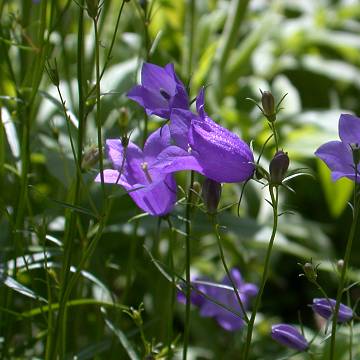

Campanula rotundifolia - (image 1 of 7)
Taxonomy
Family: Campanulaceae
Habitat
Sandy black oak savannas and beaches, hill prairies, dry woods, rocky cliffs.
Associates
Oak Savanna: Asclepias tuberosa, Ceanothus americanus, Euphorbia corollata, Liatris aspera, Rosa carolina, Tradescantia ohiensis, Vitis riparia.
Hill Prairie: Amorpha canescens, Andropogon scoparius, Anemone patens wolfgangia, Artemesia caudata, Bouteloua curtipendula.
Distribution
Circumboreal; south in North America to NJ, IN, IA, and Mexico.
Morphology
Perennial to 80 cm; stems smooth. Basal leaves rounded, petiolate, angular-toothed, to 2 cm, often deciduous; stem leaves entire, less than 1cm wide, lance-elliptic. Flowers blue to blue-violet, several in a racemiform or elongate-paniculiform inflorescence, sometimes solitary; corolla campanulate, to 3 cm, the lobes much shorter than the tube; style not exceeding the corolla. Fruit nodding, opening near the base.
Notes
Flowers early June to early October
Wetland indicator: Upland
The specific epithet refers to the rotund (rounded) leaves, although they sometimes are not present when the plant flowers. The stem leaves are much narrower.
References
Gleason, Henry A. and A. Cronquist. 1991. Manual of Vascular Plants of Northeastern United States and Adjacent Canada. Second Ed.
The New York Botanical Garden. Bronx, NY
Swink, F. and G. Wilhelm. 1994. Plants of the Chicago Region.
Indiana Academy of Science. The Morton Arboretum. Lisle, Illinois.
|
© Michael Hough 2004 |